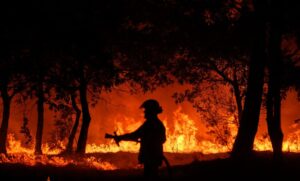An unbroken canopy of ancient eucalypts rides over the ridges of the Atherton Tablelands and disappears into the horizon. Queensland’s wet, tropical ecosystem is like nowhere else on Earth, the sacred remnants of the ancient Gondwanan forest that covered Australia before it separated from Antarctica 100 million years ago. Chalumbin Forest survived the axes of Queensland’s early settlers with its ancient ecosystem virtually intact. Yet a brutal reckoning with modernity could be just months away.
“They’re going to put the windmills in there, aren’t they?” said Tommy, my Aboriginal guide, as we looked down at the forest from a secluded bluff. “They want to really rip this whole country up.” Looking out across the landscape, with an industrial wind turbine development just a ministerial tick away from final approval, it seems a bad joke — an indictment of the skewed judgement of Australian governments for whom the race against climate change trumps everything else. The pledge of Net Zero emissions by 2050 is driving a 21st-century gold rush, forcing renewable energy companies deep into the hinterland.
Ark Energy, a Korean-backed renewables corporation, plans to bulldoze 1,100 hectares of trees at Chalumbin, which is almost twice the size of Melbourne and on the edge of a world heritage area. Dynamite will be brought in to blast ancient rocks and hilltops will be flattened to accommodate platforms for the turbines and cranes. More than 100km of roads will be carved through the forest to facilitate hundreds of truck movements delivering thousands of tonnes of concrete, gravel and steel. Engineers will supervise the smoothing of gradients and rounding of curves to ease the passage of oversize vehicles more than 100 metres long and carrying giant turbine blades from Cairns Harbour.
Once completed, the 86 towers will rise 200 metres above the tree line, polluting the view for miles. The federal government can ill-afford to press pause. It has pledged to make the east coast electricity grid 82% carbon-free by 2030. It will be no mean achievement for a grid that relies on coal and gas for more than 65% of its electricity.
The Australian Labor Party is making the task considerably harder by refusing to remove the long-standing moratorium on nuclear power. Of the dozens of jurisdictions with grids running on 80% clean energy or more, none have achieved it with wind, sunshine and water alone. Nevertheless, Chris Bowen, Australia’s pugnacious energy minister, told a business gathering last month his targets are “very, very achievable for Australia”. His timetable is ambitious: installing a 7mw wind turbine and 16,500 solar panels every 18 hours until 2030, supported by some 10,000km of new transmission lines.
Chalumbin’s fate is in the hands of environment minister Tanya Plibersek, who is expected to make a decision next month. It will be a pivotal moment, ranking alongside the decision by the Labor government of Bob Hawke 40 years ago to block the construction of a hydroelectric dam in Tasmania’s World Heritage-protected Franklin Gorge. Like this one, that decision demanded trade-offs between nature and low-carbon electricity production.
This time, however, the environmental movement that mobilised to stop the Franklin Dam is nowhere to be seen. Their single-minded attention to climate change leads them to regard the destruction of natural biodiversity as a necessary evil. And so they plough on, blind to the realisation that, in Australia as elsewhere, the expansion of wind and solar is constrained by the scarcity of land. We are re-learning the lesson that broke the hearts of Australia’s pioneering farmers in the late 19th century — that even in a country as vast and sparsely populated as this one, you eventually run out of usable terrain.
It was only a matter of time before the iron law of energy density checked the headlong rush for wind and solar. A report last month, jointly sponsored by the Universities of Melbourne, Princeton and Griffith, calculated that 120,179 square kilometres of land would be needed to produce enough renewable energy to achieve Australia’s Net Zero target. That is an area equivalent to 90% of the landmass of England, or half the size of the state of Victoria.
Understandably, not everyone supports the colonisation of this land. In April, Apple pulled out of a deal to buy power from a proposed wind development on the edge of the North Queensland rainforests at Upper Burdekin after a devastating environmental impact report. It found that constructing the wind turbine plant would destroy 769 hectares of koala habitat.
Elsewhere, politicians and environmental bureaucrats are quietly making trade-offs. A proposed wind farm on Robbin Island in north-west Tasmania will only proceed if the operators agree to it shut down for five months each year so as not to disturb the migration of the orange-bellied parrot. Construction of a wind farm in Victoria has been curtailed because of the threat to a local wetland bird species, the brolga.
Chalumbin, meanwhile, has more than its share of vulnerable species, including the greater glider — a cat-sized tree-jumping marsupial with big furry ears, large, round eyes and enormous feather boa-like tail — and the strikingly coloured magnificent broodfrog, so named because of its black and bright-orange marbling. It is also the hunting ground for the red goshawk, one of Australia’s most endangered birds of prey, whose unfortunate habit of flying into hills to gain greater uplift makes them peculiarly vulnerable to turbine strikes.
Tim Nevard, an adjunct professor at the Cairns Institute at James Cook University, describes the application to build on the site as ludicrous. “Biodiversity can’t be destroyed in order to stop climate change,” he said.
A virtue often ignored is the power of the forest to enrich the human spirit. The natural beauty of the rainforests and the Great Barrier Reef attracts 400,000 tourists a year to the region. But it also has a deeper, sacred significance to the Jirrbal people, whose ancestors were here long before the birth of Christ. Those who retain an attachment to the land through blood lines and tradition are distraught by the proposal.
“We are the people of the rainforest,” Jirrbal woman Georgina Weiden told me in a tearful interview. “That’s where life comes from for us. That’s where life begins. Nothing good can come out of it. Our people will start to get sick and suffer. Our spirits will suffer ’cause we’ll start losing connection. It’s a spiritual connection that we’re supposed to look after and protect.”
Her frustration and sense of powerlessness are shared by other Jirrbal people to whom I spoke. It underlines the hollowness of the land rights agreements that have been struck since the Nineties and now cover half the Australian land mass. Jirrbal country is held in trust by the Wabubadda Aboriginal Corporation, a commercial organisation run by an imperfectly elected clique that is only lightly accountable to the people whose interests it represents. The agreement the Corporation has struck with Ark Energy giving its blessing to the Chalumbin development is widely met with scorn by those outside the tribal elite. There is virtually no transparency about the compensation that will be paid, or how those funds will be distributed.
In response, the Jirrbal people, in alliance with local conservationists, are trying to raise funds to fly to Canberra, a distance equivalent to London to Moscow, hoping to put their case to the minister face to face. It is a measure of the unequal battle between a small regional community and the renewable energy companies that they are relying on charity for the fare. For the defenders of Chalumbin, it’s an all-or-nothing fight. If this land isn’t safe from colonisation by big renewables, where is?
“It’s my own Kakadu,” said Patricia, a Jarrbal woman, as we sat on a log overlooking the forest. “We call it Mother Earth. Like a mother looks after you, so you look after your mother, respect your mother.” Patricia recalled with some bitterness the fate of her ancestors, whom she says suffered at the hands of early settlers. She described the wind farm proposal as “just another trick”.
“It’s very cruel to First Nation people,” she said, slowly warming to her choice of words. “Yes — very cruel.”
Disclaimer
Some of the posts we share are controversial and we do not necessarily agree with them in the whole extend. Sometimes we agree with the content or part of it but we do not agree with the narration or language. Nevertheless we find them somehow interesting, valuable and/or informative or we share them, because we strongly believe in freedom of speech, free press and journalism. We strongly encourage you to have a critical approach to all the content, do your own research and analysis to build your own opinion.
We would be glad to have your feedback.
Source: UnHerd Read the original article here: https://unherd.com/




